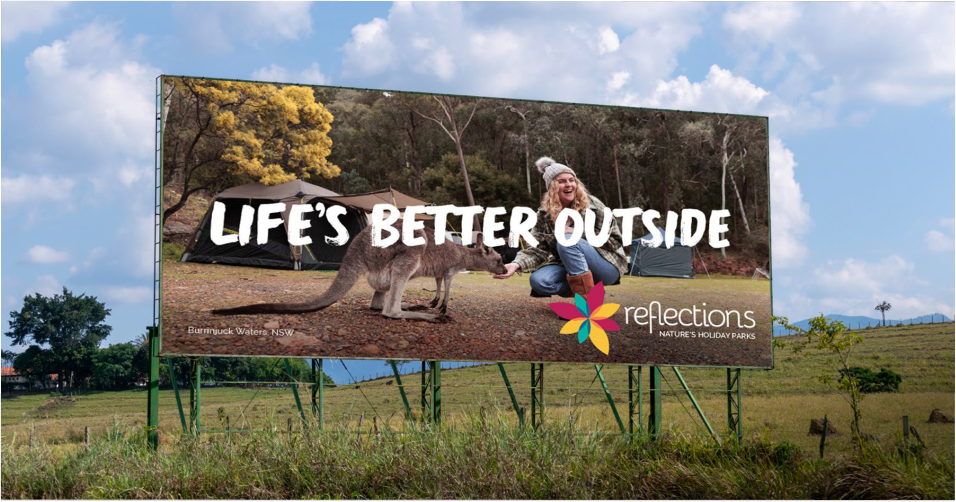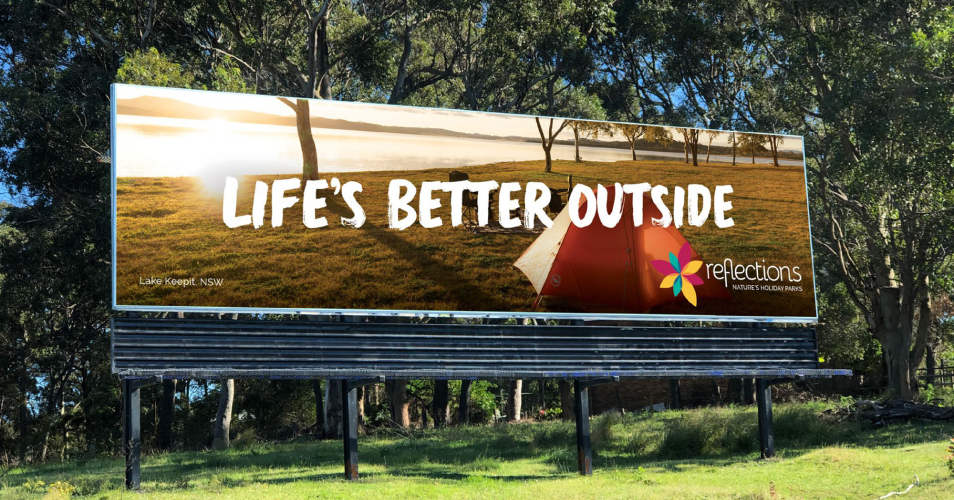Reflections gleans double-digit growth with regional media focus



Perhaps it’s the fact he grew up in regional Australia and now lives in Newcastle that helps Peter Chapman see regional marketing as a win-win for brands. Perhaps it’s his agency experience delivering stellar results through regional media for the likes of Mitre 10. Or maybe it’s his ability to recognise differences as well as similarities between regional and metro consumers guiding him through audience misconceptions still pervading marketing today.
Whatever the case, Chapman not only believes in the value of regional marketing, he’s leveraged regional media to drive 20% growth off record growth already achieved during the pandemic.
“It’s really fascinating how under-represented regional audiences are in marketing terms,” Chapman comments. “I’ve always been an advocate for regional markets, whether it’s the creative work we’re doing and where we frame it, shoot it and show it; to where we invest dollars from an agency perspective; to being client-side, where we invest our own spend.”
Chapman attributes this share versus spend discrepancy partly to the metro-skewed view of media planners. “Though they have the best intentions, regional markets get left off because they’re not top of mind as lived markets for many people making the decisions.”
Another mistaken belief Chapman spies is regional audiences being attitudinally different to metro counterparts. “Studies we’ve done show on all sorts of bigger attitudinal matters of life, regional and metro markets differ very slightly now,” he says.
“Where they do differ hugely is in behaviour. Because regional lives are lived differently, their behaviours change. You need to sympathise with that in the work.”
Most notably, regional Australians have more time. “This creates more opportunity to spend more time with your brand – as long as you’re interesting within their world,” Chapman argues. “When you move to the regions, your life is still as full of all the things you want to do. You’ve still got work, you work the same hours, you’ve still got all the things your kids are doing. You still have the book club, play recreational sports, go to the gym and visit family and friends.
“What you don’t have is all those other connection pieces taking up so much time. You’re not spending an hour a day in traffic, and a play date is not 45 minutes away. You’re not waiting half an hour to get on or into something.”
Combine this concept of time with the fact attention is more accessible in regional markets because you’re fighting less for headspace, and you’re onto a winning formula for growth.
“You have 30% of the country living in an area where brands are only spending 10% of their money. Straight away from a share of voice perspective, it’s cheaper to buy regional Australian eyeballs or eardrums than it is to buy metropolitan ones,” Chapman says. “That is if your market segments are split equally between regional and metropolitan audiences. For big companies with commodity products particularly, that is true. But it’s also true for products accessible through regular channels or online. It just makes better sense to buy regional.”

Not surprisingly, Chapman therefore decided to centre Reflections’ first above-the-line campaign in 2022 wholly in regional markets.
“Reflections had a digital strategy before I turned up. That was for a few reasons, including providing quick wins early to drive market share. But it didn’t allow the brand to specifically target different geographic areas,” Chapman explains.
In segmenting the market to better understand where core customers came from, Chapman also discovered 65% of Reflections’ audience lives in regional New South Wales.
“With my preference for regional markets, and knowledge the industry is underspending by 20 percentage points in terms of cost of share of voice versus market size, it was a no-brainer to really back regional markets,” Chapman says.
Reflections’ media strategy incorporated regional outdoor, TV and radio channels. For example, the brand invested in an out-of-home buy centred around major driving routes in regional areas.
“What’s interesting is you’re not only capturing regional audiences, you’re capturing people travelling through the regions, particularly in peak holiday times,” Chapman says.



With radio, Reflections bought within key markets, building relationships with DJs and embarking on giveaways, breakfast team campaigns, plus spots and dots media buying. With TV, it bought into peak times.
“In regional, you can afford to for a start, but it puts your brand among great company and gives you peak audiences. We supplemented with BVOD,” Chapman says. Activities also included major sponsorships, such as naming rights sponsorship of Surfest, a major World Surfing League program run out of Newcastle.
Complementing a regional-first media plan was a repositioning of the brand nationally to celebrate the outdoors more, distinguishing Reflections from other holiday park operator brands. Creative and messaging was underpinned by the consistent brand platform, ‘Life’s better outside’.
“What we found to be successful is you build the same kind of creative idea and creative platform, which should be laddering up to a higher, human truth. But the way you place and frame it in regional markets is different,” Chapman says. “That becomes more of a media discussion than a creative one. Sometimes, it’s about creative use of media.
“For instance, in the metro markets in radio, we might buy peak periods and traffic reports because we’re trying to get people on holidays. The great insight there is those consumers will be most frustrated with their busy city lives when they’re sitting in traffic. We wouldn’t do that in regional New South Wales. But you might serve really similar creative.”
Nuanced media placement doesn’t deliver a big ‘Tada’ moment in itself, Chapman admits. “The lack of severity of differences between audiences is where the story is,” he says.
“There’s an argument to say for certain products you might change creative. But just because someone in Bathurst isn’t driving a Ford Fiesta through the city streets, it doesn’t mean they don’t want to go and buy one to say something about the kind of person they are. In the same way a Mum on the Northern Beaches is not driving her Volvo in the Swiss Alps.
“We call it looking from the ‘outsight’, which is the opposite to an insight. Many brands frame up regional life in a really unauthentic way, and it misses big time.”
Brand health work, which Reflections segments down to Statistical Area Level 4, provides further insights granularity when connected with other data sources like coded sales data, shared with its media agency to feed into Helix and Mosaic tools for profiling and segmentation. Chapman also stresses brands should better ensure the mix of customers they’re talking to reflects Australia’s make-up. By overindexing on regional people it talks to, Reflections has statistically significant numbers to drill down into data more effectively.


Two phenomenal outcomes from Reflections’ regional marketing efforts were attained. The first was growing business by 20%.
“To grow a domestic holiday business 20% on top of what was the biggest year we’d ever seen because of domestic travel growth during Covid was a huge achievement. A big part of that was our marketing efforts and where we focused them,” Chapman says. “We had a large CRM program and presence in our digital performance too – these are foundational things. What we did differently was built a regional-only, above-the-line media campaign centred around radio, peak TV and out-of-home on major arterial roads. That drove that growth.”
Another milestone result was +40% prompted brand awareness growth against an original benchmark of +10%. Brand health metrics in fact all shot up, from prompted and unprompted awareness to consideration. Simultaneously, ‘likely not to consume’ or ‘likely not to stay’ figures went down.
“This told us we were driving affinity with our markets in the right way,” Chapman says. “What’s interesting is while we only focused on regional, we also grew our metro markets.
“Couple brand health growth, which indicates growth in future demand, with immediate demand growth of 20%, and we felt like we’d build a really holistic program that’s growing the business in a sustainable way.”

To grow a domestic holiday business 20% on top of what was the biggest year we’d ever seen because of domestic travel growth during Covid was a huge achievement. A big part of that was our marketing efforts and where we focused them.
Nevertheless, Chapman had to convince the board of the viability of an above-the-line media play. A first step was benchmarking how the market and competitors were spending.
“Secondly, we talked about the idea that growing share of voice will grow share of market. We lent on empirical data that exists, particularly through The Long and the Short of It work by Les Binet and Peter Field in the UK,” Chapman says. “This says the more effective advertising you put into market, the more you will build your market share. If you make that argument well, you then look at regional Australia and say buying share of voice, which we all agree will help us gain market share, is cheaper and more effective in those markets.
“So the question becomes: How much can we tip into it to exponentially grow the business?”
With such results realised, Chapman is in no doubt of the value of Reflections continuing a regional-first approach. “We have so much room to grow in regional Australia; there’s still a lot more fruit on those trees,” he adds.



